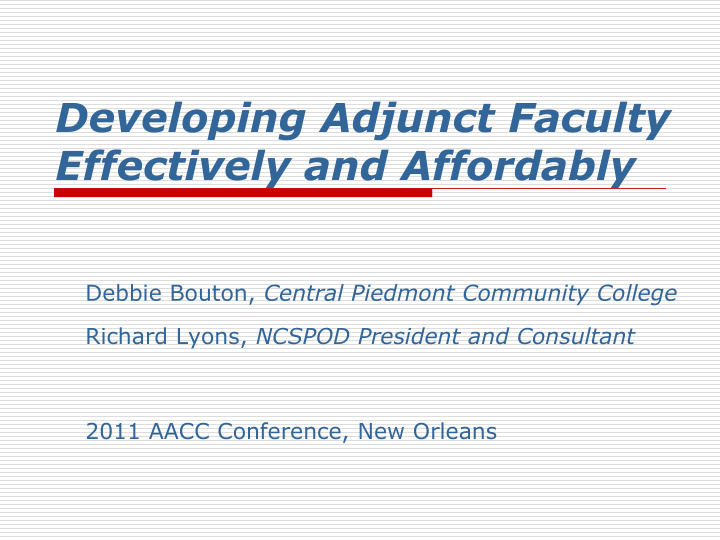



Developing Adjunct Faculty Effectively and Affordably Debbie Bouton, Central Piedmont Community College Richard Lyons, NCSPOD President and Consultant 2011 AACC Conference, New Orleans
Benefits Part-timers Provide Cost savings Scheduling flexibility Expertise in critical fields Passion for sharing their wisdom Connections to the community Fresh perspectives Diversification of faculty Source of potential full-time faculty
Costs of Inadequate Support Suboptimal teaching performance Faulty communications with students More “fires” for leaders to extinguish Suboptimal student retention rates
Common Needs of Part-timers Grounded orientation to institution Basic teaching toolkit Sense of belonging Continuing development of skills Recognition for quality teaching
Myth Busters: Lessons Learned Won’t come for training unless paid Won’t come for training, schedule conflicts Don’t have time to work on teaching skills Can’t find a full -time teaching position
Continuous Outreach: Fosters Sense of Belonging Orientation Part-time Faculty Website Semester Community Meeting Teaching Commons Certification Program Evening and Saturday sessions
Orientation Provide “Welcome Goodie Bag” Offer multiple times, multiple locations Introduce college administrators Include icebreakers Model good teaching practices Offer online option
24/7 Support: PTF Website http://www.cpcc.edu/parttime
Semester Community Meetings Response to survey data Provides opportunity to “build community” Selected focused topics: Building community in the classroom Effective use of technology
Evening & Saturday Sessions Meet needs and schedules of part-time faculty Monthly Sessions: Becoming a Student Advocate Blackboard Team play Active learning strategies
Teaching Commons Workspace to share ideas and content, develop methodologies, stimulate innovation Promotes and supports: Collaboration, sharing and collegiality Innovation Individual development
Resources for Adjunct Faculty Email for all part-time faculty Touch-down stations at each campus Assistance from instructional developers Representation on College Senate Professional development opportunities
Certification Program Teaching for Significant Learning 25-hour, hybrid program Participants recommended by departments Stipend paid upon completion of program Getting Results is primary curriculum AdjunctSuccess.net webinar series
Certification Program Teaching for Significant Learning Topics Creating a Community of Learners Planning for Outcomes Active Teaching and Learning Assessing Teaching and Learning Teaching with Technology
Certification Program Teaching for Significant Learning Evaluation Instructor Self Assessment (pre and post) Follow-up Instructor Self Assessment (6 mo) Survey of Students Student Success Rates (pre and post) Student Retention Rates (pre and post)
Positive Effects & Sustainability Increased: PTF completing orientation Retention of PTF Students’ grades Doubled professional development participation Adopted model for use with Developmental Education Initiative
Follow Up Survey Feedback 80% agree: “I feel valued in my department in my roles as a part- time instructor.” “Professional development classes and seminars I have attended have really helped me to evaluate my own teaching.” “I love working for CPCC. I currently adjunct for multiple institutions, and CPCC is the one that really makes me feel well-supported and in touch.”
Results of Certification Summer 2008 Group Terms ABCS % ABCS AS - UF % AS-UF DFIWU %DFIWU Total Pre-Cert 2007-2008 3062 66.6% 3753 81.6% 1538 33.4% 4600 Post-Cert 2008-2008 6384 71.7% 7793 87.5% 2524 28.3% 8908 Summer 2009 Group Terms ABCS %ABC AS - UF % AS-UF DFIWU %DFIWU Total Pre-Cert 2008-2009 4087 70.2% 5398 92.7% 1734 29.8% 5821 Post-Cert Fall 2009 2849 71.9% 3648 92.1% 1111 28.1% 3960
Retention of Participants Taught in Taught in Not Taught in Not 2007/2008 Fall 2008 Retained Fall 2009 Retained Participants in Summer 43 40 3 2008 43 (100%) 0 (93%) (7%) Participants in Summer 56 4 2009 60 (93%) (7%) 93-100% retention versus 65% for entire part-time faculty group over same periods.
Model Options Institutionally-developed initiatives Externally-sourced approaches Hybrid approaches
Why Online Aligns Well Geographical dispersal of adjuncts Just-in-time availability Cost savings: institution and instructor Can foster low-risk mentoring Reduced management time required
Program Commonalities Requires a persistent champion Constrained by institutional culture Strategically designed, implemented Sustainability requires forethought Challenging to schedule f2f sessions
Assessment Findings Adjuncts must be incentivized Content must be engaging, relevant Programs require active marketing and management Requires designated point person Blended surpasses f2f achievements Recognition improves commitment
Benefits of Systematic Program Deeper student learning Improved accountability outcomes Enhanced ongoing coordination Increased synergies with community Fewer crises for instructional leaders Improved retention of best adjuncts
Bibliography Gappa, J. and Leslie, D. [1993], The Invisible Faculty , San Francisco: Jossey-Bass. Leslie, D. and Gappa, J. [2002]. “Part -time Faculty: Competent and Committed,” in Community College Faculty: Characteristics, Practices, and Challenges , San Francisco: Jossey-Bass. Lyons, R.. Editor [2007], Best Practices for Supporting Adjunct Faculty , San Francisco: Jossey-Bass. Lyons, R. [2003]. Success Strategies for Adjunct Faculty , Boston: Allyn and Bacon. Lyons, R., Kysilka, M. and Pawlas, G. [1999], The Adjunct Professor’s Guide to Success , Boston: Allyn and Bacon.
Questions and Answers As time allows Afterwards: Debbie.Bouton@cpcc.edu Richard.Lyons@ncspod.org
Recommend
More recommend